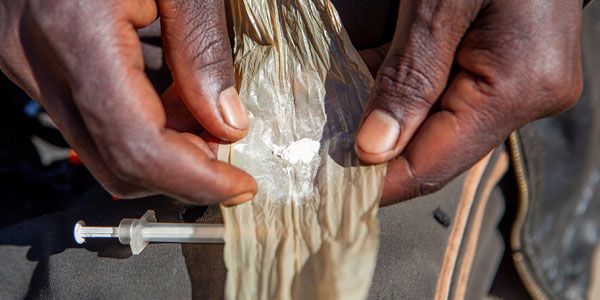Blocking the opioid pipeline
- Beth Amato
Treating opioid addiction is a painful, time consuming and often frustrating process. New medication can help solve this problem.

The drug nyaope has ravaged poorer communities in South Africa, with youth among the overwhelming majority caught in this opioid dragon's talons.
Nyaope is a highly psychologically and physiologically addictive drug, which makes it an enormously difficult habit to kick, once addicted. Severe illnesses (including collapsed and infected veins, damaged heart valves and the effects of diseases transmitted when using) and death are common.
Nyaope, also known as pinch, sugars or whoonga, is made of low-grade ('black tar') heroin, marijuana and antiretrovirals. Often, dangerous substances such as rat poison and pool cleaner are cut in. It can be snorted, smoked or taken through "bluetoothing", where one addict shares their blood with another through a minor blood transfusion. One hit can cost as little as R20 and is enough to get you hooked. Its high lasts between 6 and 24 hours and if not ingested again, withdrawal symptoms include vomiting and body aches.
Opioid use disorder
Part of the reason that so many struggle to escape nyaope's grip is that medical treatment for rehab is expensive, and therapeutics are cumbersome to administer and maintain. One of the current treatment drugs, Suboxone, is taken twice a day until the physical addiction is managed. An addict may claw their health back only through a long-term and multipronged approach.
"With the current treatment options available, people living with opioid use disorder (OUD) have to take treatment drugs at frequent intervals, with which patients find difficult to comply. Furthermore, current drugs used to treat opioid addiction only last six hours. Even then, only 50 to 60% of the drug treatment is bioavailable to the patient," says Sarjan Patel, a Master's student at the Wits Advanced Drug Delivery Platform (WADDP).
The drug treatment is available in tablet, intravenous drip (IV) and implant form. While the range of options has improved, and with that better compliance, a long-term option is desperately needed.
Without buprenorphine and suboxone (the main treatment options), a patient has intense cravings and unfortunately, the chance of relapse is extraordinarily high.
A cheaper, quicker treatment
Patel has worked over the past 18 months under the supervision of Professor Yahya Choonara and Dr Mershen Govender to produce a targeted, sustained-release drug delivery system for OUD. He notes that the effective treatment of OUD requires a combination of drugs, which the delivery mechanism can offer.
Patel explains that the drugs to treat OUD (which are few and far between) compete to bind to the opioid receptors in the patient’s body and block the release of dopamine, which ignites feelings of pleasure. Even if an addict takes a hit of opioids, it won't find "space" and is unable to bind on receptors and so it loses its effect. "It is an amazing 'blocking' system and one administration is equivalent to 14 tablets”.
With the new treatment, the patient will only need a weekly dose. "We hope that this will reduce costs and become a long-term treatment for OUD," says Patel.
Urgent need for opioid substitution therapy in SA
Opioid use disorders, including heroin, which is widely available in South Africa, account for 70% of the global burden of drug-related disease and disproportionately affect the poor. In addition, there is the concern around the link between injecting heroin, hepatitis C virus and HIV and the impact this has on communities and healthcare systems.
Consequently, the inclusion of opioid substitution therapy (OST) in the 2018-2022 National Drug Master Plan is a welcome development. Before this, there was a dearth of treatment options and the high cost of methadone, a common OST treatment drug, remains an issue. The Sultan Bahu Centre in the Western Cape, which opened its doors as a pilot site for OST in 2015, was the first of its kind. Others have been established since, but too few to beat the pernicious opioid beast.
This is why Patel's Master's research at the WADDP is so important. "What’s really notable is that the delivery system in development is flexible enough to deliver other drug treatments. We are testing it for OUD, but there is a lot more potential to deliver life-saving treatment drugs in a cost-effective and longer acting way,” says Patel.
- Beth Amato is a freelance writer.
- This article first appeared in?Curiosity,?a research magazine produced by?Wits Communications?and the?Research Office.
- Read more in the 16th issue, themed: #Drugs, where we highlight the diversity, scope, and multi-dimensional nature of drug-related research at Wits University.
